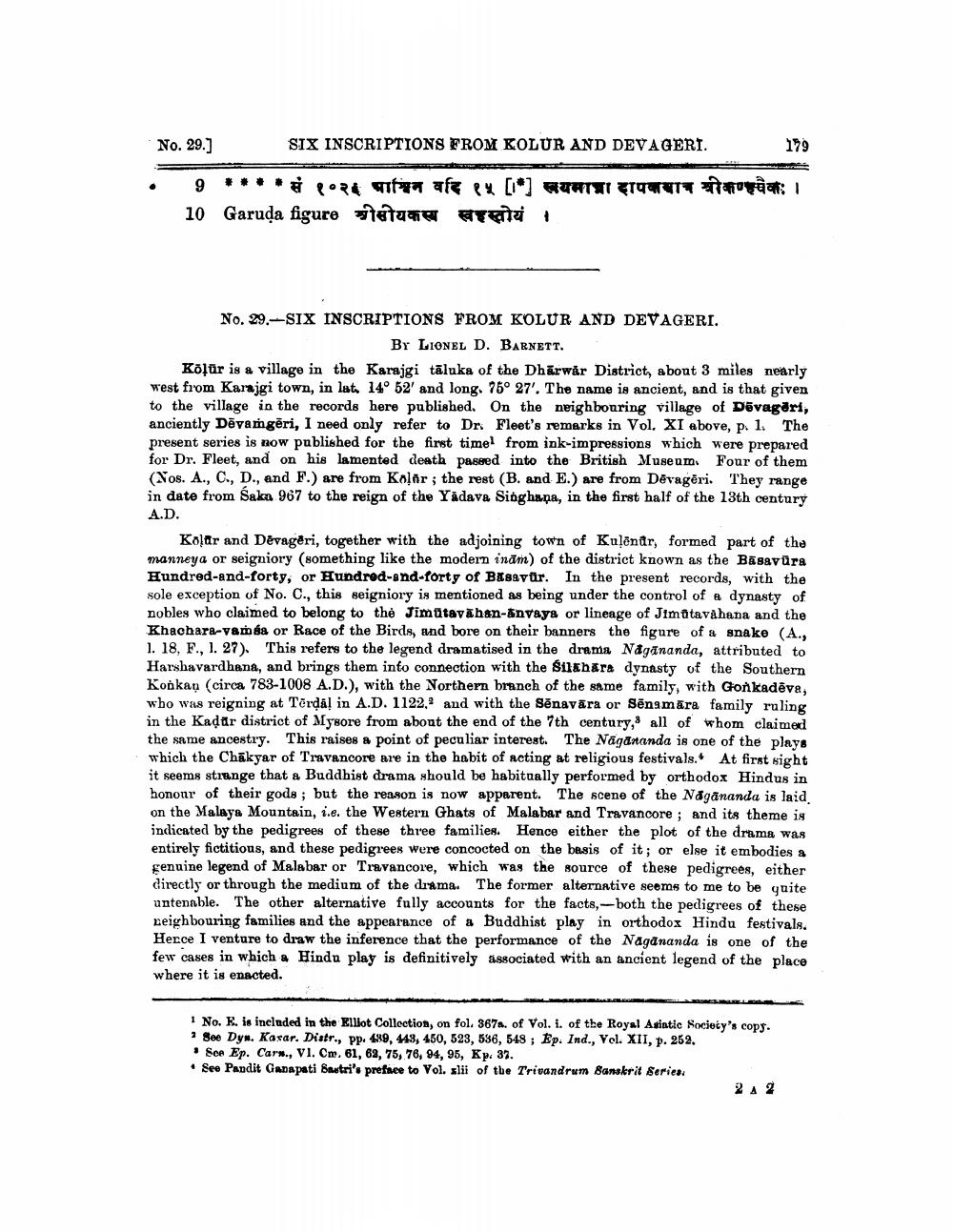________________
No. 29.]
SIX INSCRIPTIONS FROM KOLUR AND DEVAGERI.
179
•
9**.. Pora na af px [*) HUHTWI TOTT Fora: 1 10 Garuda figure støtte E U
No. 29.-SIX INSCRIPTIONS FROM KOLUR AND DEVAGERI.
BY LIONEL D. BARNETT. Kölür is a village in the Karajgi tāluka of the Dharwår District, about 3 miles nearly west from Karajgi town, in lut 14° 52' and long. 75° 27'. The name is ancient, and is that given to the village in the records here published. On the neighbouring village of Dāvagari, anciently Dēvangēri, I need only refer to Dr. Fleet's remarks in Vol. XI above, p. 1. The present series is now published for the first time from ink-impressions which were prepared for Dr. Fleet, and on his lamented death passed into the British Museum Four of them (Xos. A., C., D., and F.) are from Kolor; the rest (B. and E.) are from Dēvagēri. They range in date from Saka 967 to the reign of the Yadava Singhaņa, in the first half of the 13th century A.D.
Koļur and Devageri, together with the adjoining town of Kulēnir, formed part of the manneya or seigniory (something like the modern inām) of the district known as the Bāsavura Hundred-and-forty, or Hundred-and-forty of Bisavür. In the present records, with the sole exception of No. C., this seigniory is mentioned as being under the control of a dynasty of nobles who claimed to belong to the Jimitavāhan-nyaya or lineage of Jimatavahana and the Khachara-vamsa or Race of the Birds, and bore on their banners the figure of a snake (A., 1. 18, F., 1. 27). This refers to the legend dramatised in the drama Nagānanda, attributed to Harshavardhana, and brings them into connection with the silxhara dynasty of the Southern Konkan (circa 783-1008 A.D.), with the Northern branch of the same family, with Gonkadēva, who was reigning at Terdal in A.D. 1122, and with the Sēnavāra or Sēngmāra family ruling in the Kadar district of Mysore from about the end of the 7th century, all of whom claimed the same ancestry. This raises a point of peculiar interest. The Nāgananda is one of the plays which the Chākyar of Travancore are in the habit of acting at religious festivals. At first sight it seems strange that a Buddhist drama should be habitually performed by orthodox Hindus in honour of their gods; but the reason is now apparent. The scene of the Nagananda is laid on the Malaya Mountain, i.e. the Western Ghats of Malabar and Travancore ; and its theme is indicated by the pedigrees of these three families. Hence either the plot of the drama was entirely fictitious, and these pedigrees were concocted on the basis of it; or else it embodies & genuine legend of Malabar or Travancore, which was the source of these pedigrees, either directly or through the medium of the drama. The former alternative seems to me to be quite untenable. The other alternative fully accounts for the facts,--- both the pedigrees of these Leighbouring families and the appearance of a Buddhist play in orthodox Hindu festivals. Hecce I venture to draw the inference that the performance of the Nagananda is one of the few cases in which a Hindu play is definitively associated with an ancient legend of the place where it is enacted.
1 No. E, is included in the Killot Collection, on fol. 3678. of Vol. i. of the Royal Asiatic Society's cops. * See Dyn. Kasar. Distr., pp. 489, 449, 450, 523, 536, 548; Ep. Ind., Vol. XII, p. 262. • Sce Ep. Cars., VI. Cm. 61, 62, 75, 76, 94, 95, Kp. 37. • See Pandit Ganapati Bastri's preface to Vol. slii of the Trivandrum Sanskrit Series




